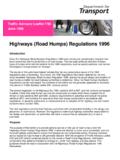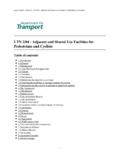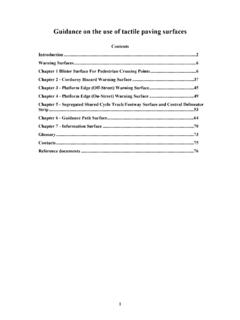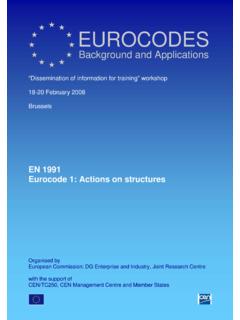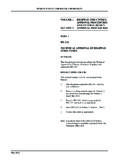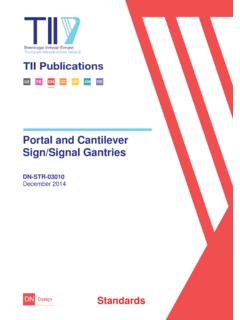Transcription of SUPPORT DESIGN FOR UK TRAFFIC SIGNS Fully …
1 May 2008 sign STRUCTURES GUIDESUPPORT DESIGN FORUK TRAFFIC SIGNSF ully revised toBS EN 12899-1:2007 Published by theInstitute of Highway Incorporated EngineersDe Morgan House58 Russell SquareLondonWC1B 4 HSTel: 020 7436 7487 Fax: 020 7436 7488 DesignWendy Hooper: WDH Publishing Services Ltd, EssexSimon MorganFirst published September 2007 Revised edition published May 2008 All rights reserved. No part of this publication shall be reproduced without the writtenpermission of the publishers. 2008 Institute of Highway Incorporated EngineersISBN: 0 9542875 2 5 sign Structures Guide SUPPORT DESIGN for UK TRAFFIC SIGNS to BS EN 12899-1:2007 May 2008 2 sign STRUCTURES GUIDE ACKNOWLEDGEMENTS The Institute of Highway Incorporated Engineers would like to thank the following for producing this guide.
2 Editor Simon Morgan, Buchanan Computing Authors Jim Gallagher, Highways Agency Kirsten Morris, Mott MacDonald Simon Morgan DESIGN Wendy Hooper, WDH Publishing Services Ltd Simon Morgan The example calculations were prepared by Mott MacDonald for work commissioned by the Highways Agency. About the authors All the authors have been closely involved with the preparation of guidance for the new UK National Annex to BS EN 12899-1. Simon Morgan, MA, MSc, CEng, CITP, MICE, is managing director of Buchanan Computing and a director of Colin Buchanan. He is a member of a number of national bodies related to TRAFFIC SIGNS , including the BSI committee responsible for BS EN 12899 and its National Annex, and is the author of SignPlot and SignLoad software for the DESIGN of sign faces and sign structures.
3 James Gallagher, BSc(Hons), CEng, MICE is senior structures advisor at the Highways Agency in Manchester. His responsibilities include the introduction and implementation of both BS EN 12899 and the passive safety standard BS EN 12767 on the English trunk road network. Kirsten Morris, BSc, CEng, MICE, FIStructE is a structures DESIGN team leader at Mott MacDonald in Southampton. She manages the structural DESIGN of sign supports and foundations for the Highways Agency Area 3 and has led the modification of the DESIGN method for SIGNS to comply with the Eurocodes. She has experience in providing technical advice for the development and use of passively safe posts as sign supports.
4 sign STRUCTURES GUIDE 3 CONTENTS Acknowledgements ..2 1. 2. Background Information on Wind 3. Background Information on SUPPORT DESIGN ..11 4. Foundation Appendix A: Table of National Annex (omitted from this version)..13 Appendix B: Flowchart for Determining Wind Load ..16 Appendix C: Examples ..17 Appendix D: 4 sign STRUCTURES GUIDE 1. INTRODUCTION The DESIGN of supports for TRAFFIC SIGNS has changed significantly as a result of the introduction of European standards. This booklet attempts to clarify the current situation and to provide a reference for all those involved with TRAFFIC signing.
5 Much of Appendix C requires some understanding of structural engineering, but the bulk of this publication is intended for use by TRAFFIC and highway engineers: the people who most often need to specify sign structures. In conjunction with suitable computer software, it will cover most situations. It is nevertheless recommended that the advice of a structural engineer should be sought in cases of any doubt and always for larger SIGNS and those mounted above the carriageway. For many years sign structure DESIGN in the UK was standardised, a single wind pressure being used throughout the country.
6 However, the relevant standard, BS 873, was withdrawn at the end of 2005, being replaced initially by BS EN 12899-1:2001 and now by BS EN 12899-1:2007. One of the changes from BS 873 is the need to specify what wind pressure each sign needs to withstand. There is thus an additional step in the DESIGN process that this Guide helps to explain. The European standard offers a wide range of classes for each aspect of a sign s performance, in order to address the requirements of all participating countries. To assist designers of TRAFFIC SIGNS in the UK and to encourage consistency where it is appropriate, the UK version of the standard, BS EN 12899-1:2007, has a National Annex appended to it.
7 This contains recommended values and classes for the options, including for wind loading, as is therefore an invaluable reference. The determination of the wind load and the DESIGN of the structure are two essentially separate tasks that do not necessarily need to be undertaken by the same person or organisation. It is recommended that when a wind load is recorded or communicated between organisations as part of a sign specification, this should be the basic wind pressure, wb. This is the load prior to the application of any safety factor or force coefficient, and is equivalent to and comparable with the values in Table 8 of BS EN 12899-1:2007 and table of its National Annex.
8 As the nine WL classes in BS EN 12899-1:2007 differ from those in the previous edition, the use of the basic wind pressure is recommended in preference to stating a WL class to avoid any confusion as to which version of the standard is intended, and to permit the range to be extended and intermediate values specified. The UK National Annex to BS EN 12899-1:2007 published on 30 April 2008 includes a table of suitable wind pressures, broken down by country or region and overall sign height. It does not address SIGNS over 7 m total height, nor those at an altitude of more than 250 m above sea level.
9 This advice is the result of work commissioned by the Highways Agency and significant discussion amongst industry experts. The intention was to produce guidance that was (a) reasonably simple to use, (b) complied with current standards on wind actions and (c) resulted in economic SUPPORT sections that were comparable with those typically specified under previous standards. Inevitably this requires a much more detailed appraisal of the sign and its location than using a blanket wind load value. This booklet explains how to use this new method. Those involved in designing the faces of TRAFFIC SIGNS , particularly directional SIGNS , should be aware that they frequently have a choice of layout and that the size and cost of the supporting structure will depend upon how they use this freedom.
10 For example, a tall narrow sign requires stronger posts and foundations than a landscape format sign of the same area. Even where the available width is constrained, precluding a major rearrangement of the layout, it is often possible to reduce the sign face area by altering the positions of text and symbols to eliminate some of the blank space. In certain situations splitting directional information across two separate SIGNS in advance of a junction is preferable to using a single large sign , for both driver perception and structural reasons. However, when attempting to reduce the size of a sign on no account should the size of lettering or the layout guidance sign STRUCTURES GUIDE 5 in the TRAFFIC SIGNS Manual and DfT working drawings be compromised, as this would degrade the readability of the sign and make it less suitable for its primary purpose of helping the road user.

